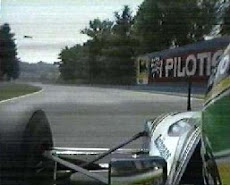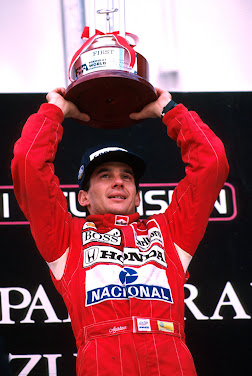
 Ayrton Senna started his career in kart, with 13 years old, and won the South American title in 1977, as well as vice world championship. In 1981, Senna made his debut in Formula Ford and won the title in the category once in his first season. In 1982, he went to Formula 2000 and ended the year as English and European champion, in addition to the record of 21 wins, 15 pole positions and 21 fastest laps. Prior to joining Formula 1, Senna passed by the British Formula 3 and won another title. In the main category of car, the tricampeão won 41 wins and 65 pole positions, and is considered one of the greatest pilots of the F-1 history.
Ayrton Senna started his career in kart, with 13 years old, and won the South American title in 1977, as well as vice world championship. In 1981, Senna made his debut in Formula Ford and won the title in the category once in his first season. In 1982, he went to Formula 2000 and ended the year as English and European champion, in addition to the record of 21 wins, 15 pole positions and 21 fastest laps. Prior to joining Formula 1, Senna passed by the British Formula 3 and won another title. In the main category of car, the tricampeão won 41 wins and 65 pole positions, and is considered one of the greatest pilots of the F-1 history. 
In addition to the powers in the tracks, Senna was also known for generosity outside. He started work philanthropic giving rise to the Ayrton Senna Institute, which now serves about 400 thousand children and young people throughout Brazil. Viviane, his sister, plays the project since its creation. After Senna's death it was discovered that he had donated millions of dollars of his personal fortune (estimated at $400 million at the time of his death) to children's charities, a fact that during his life he had kept secret. His foundation in Brazil, Instituto Ayrton Senna, has invested nearly US$ 80 million over the last twelve years in social programs and actions in partnership with schools, government, NGOs, and the private sector aimed at offering children and teenagers from low-income backgrounds the skills and opportunities they need to develop to their full potential as persons, citizens and future professionals.
 His importance to the Formula 1 is summarized in a statement from Bernie Ecclestone, big boss of the category. According to him, Senna was the greatest driver of all time, status of which neither Michael Schumacher is approaching. "Ayrton had a charisma that Schumacher was not able to transmit" said Bernie Ecclestone, Formula 1's big boss.
His importance to the Formula 1 is summarized in a statement from Bernie Ecclestone, big boss of the category. According to him, Senna was the greatest driver of all time, status of which neither Michael Schumacher is approaching. "Ayrton had a charisma that Schumacher was not able to transmit" said Bernie Ecclestone, Formula 1's big boss.
 Check out some numbers on the winning career of Ayrton Senna:
Check out some numbers on the winning career of Ayrton Senna:
Titles in Formula 1: 3 in 1988, 1990, 1991 (all with McLaren-Honda)
Wins: 41
Pole positions: 65
Points: 614
GPs disputed: 161
GPs finalized: 105
Premiuns: 80
Laps in leadership: 2,987
Miles in leadership: 13,676
Total laps travelled: 8,219
Total kilometers travelled: 37,934
Poles in the first row: 87
With wins pole position: 29
Wins for end to end: 19
Laps faster: 19
Maximum poles achieved in a single season: 13 (in 1988 and 1989)
Pole positions in succession: 8, in the following GPs: Spain, Australia, Brazil, San Marino, Monaco, Mexico and USA (1988) and Brazil (1989) Notable quotations:
Notable quotations:
"Winning is like a drug, I cannot justify in any circumstances coming second or third.
"Being second is to be the first of the ones who lose."
"On a given day, a given circumstance, you think you have a limit. And you then go for this limit and you touch this limit, and you think, 'Okay, this is the limit'. And so you touch this limit, something happens and you suddenly can go a little bit further. With your mind power, your determination, your instinct, and the experience as well, you can fly very high."
"One particular thing that Formula-1 can provide you, is that you know you're always exposed to danger. Danger of getting hurt, danger of dying. This is part of your life, and you either face it in a professional, in a cool manner, or you just drop it, just leave it and don't do it anymore really. And I happen to like too much what I do to just drop it, I can't drop it."
"Racing, competing, it's in my blood. It's part of me, it's part of my life; I have been doing it all my life and it stands out before everything else."
"There are no small accidents on this circuit." - talking about the Imola circuit before the fatal 1994 race.
"It's going to be a season with lots of accidents, and I'll risk saying that we'll be lucky if something really serious doesn't happen." - pre-season 1994.
"I continuously go further and further learning about my own limitations, my body limitation, psychological limitations. It's a way of life for me."
"Of course there are moments that you wonder how long you should be doing it because there are other aspects which are not nice, of this lifestyle. But I just love winning."
"If you have a target in your life, a real target, doesn't matter if you are very poor or rich people, if you work hard and believe in God, you can get the success, success in the life."
"I know that it is impossible to win always. I just hope that defeat doesn't come this weekend."
"I don't know driving in another way which isn't risky. Each one has to improve himself. Each driver has its limit. My limit is a little bit further than other's."
"If I ever happen to have an accident that eventually costs me my life, I hope it is in one go. I would not like to be in a wheelchair. I would not like to be in a hospital suffering from whatever injury it was. If I'm going to live, I want to live fully. Very intensely, because I am an intense person. It would ruin my life if I had to live partially." (January 1994, 4 months before to his death).

Professor Sidney Watkins, a world-renowned neurosurgeon and Formula One Safety Delegate and Medical Delegate, head of the Formula One on-track medical team, who performed an on-site tracheotomy on Ayrton Senna, reported:“He looked serene. I raised his eyelids and it was clear fromhis pupils that he had a massive brain injury. We lifted him from the cockpit and laid him on the ground. As we did, he sighed and, although I am totally agnostic, I felt his soul depart at that moment."

The FW16's new rear end was introduced at Imola. It was ironic that at the beginning of 1994 Senna himself told the press that he would be surprised if there would be no large accidents that year. He referred to the fact that after the wide "white label" 26 inch Goodyear slicks were banned for 1993 (replaced by "yellow label"), now the technology at the very core of the cars, the science around which they had been based for the last few years (active suspension, traction control and ABS) was also banned for 1994. He surmised that the cars would have trouble staying on the road, which is exactly what was observed at the beginning of 1994. J. J. Lehto damaged his vertebrae at Silverstone in January and Jean Alesi broke his neck in pre-season testing, prior to Ratzenberger's and Senna's fatal accidents at Imola. During qualifying for the next race at Monaco, Karl Wendlinger suffered an accident which left him comatose for months; Ratzenberger's replacement, Andrea Montermini, broke his feet in the Simtek in Barcelona, and Pedro Lamy broke both knee-caps in testing at Silverstone in May.
The Williams team was entangled for many years in a court case with the Italian prosecutors over manslaughter charges, but they were found not guilty and no action was taken against Williams. In 2004, the case was re-opened, but closed again in 2005 when there was no new evidence.At the conclusion of the Italian trial, Senna's FW16, chassis number 02, was returned to the Williams team. The team reported that the car was destroyed.His death was considered by many of his Brazilian fans to be a national tragedy, and the Brazilian government declared three days of national mourning. More than 1 million persons followed Senna's burial in São Paulo. Senna is buried at the Cemitério do Morumbi in his hometown of São Paulo.
I have no idols, I have no passions I have no heroes.
The only one were Ayrton Senna da Silva,
The Magic Senna.
From that 1st May
I have never watched F1 again.
And I never will.
*
RIP
Name: Ayrton Senna da Silva
Nationality: Brazilian
Date of birth: March 21, 1960 - Sao Paulo, Brazil
Date of death: May 1, 1994 - Imola, Italy
*
Monumental genius, frightening commitment,

texts: wikipedia and globo online

